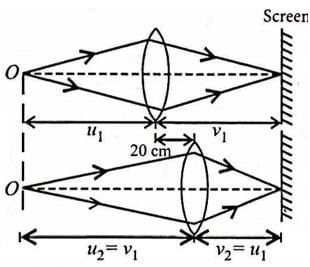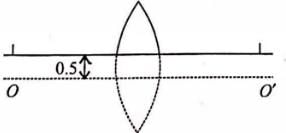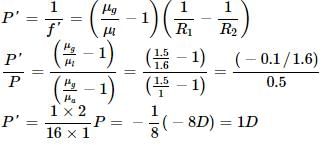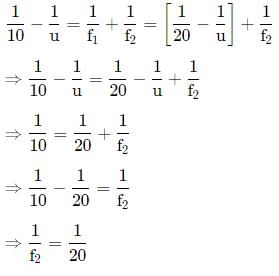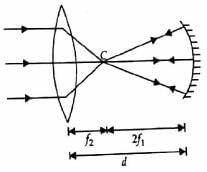Test: Refraction at Spherical Surfaces & Lenses (NCERT) - NEET MCQ
30 Questions MCQ Test - Test: Refraction at Spherical Surfaces & Lenses (NCERT)
The radii of curvature of the surfaces of a double convex lens are 20cm and 40cm respectively, and its focal length is 20cm. What is the refractive index of the material of the lens?
A convex lens is dipped in a liquid whose refractive index is equal to the refractive index of the lens. Then its focal length will
A convergent beam of light passes through a diverging lens of focal length 0.2m and comes to focus 0.3m behind the lens. The position of the point at which the beam would converge in the absence of the lens is
Radii of curvature of a converging lens are in the ratio 1:2. Its focal length is 6cm and refractive index is 1.5. Then its radii of curvature are
A man is trying to start a fire by focusing sunlight on a piece of paper using an equiconvex lens of focal length 10 cm. The diameter of the sun is 1.39 × 109 m and its mean distance from the earth is 1.5 × 1011m. What is the diameter of the sun's image on the paper?
A square card of side length 1mm is being seen through a magnifying lens of focal length 10cm. The card is placed at a distance of 9cm from the lens. The apparent area of the card through the lens is
A converging lens is used to form an image on a screen. When the upper half of the lens is covered by an opaque screen
Which of the following forms a virtual and erect image for all positions of the object?
A real image of a distance object is formed by a plano-convex lens on its principal axis. Spherical aberration is
An object is placed at a distance of 1.5 m from a screen and a convex lens is interposed between them. The magnification produced is 4. The focal length of the lens is then
The image of the needle placed 45 cm from a lens is formed on a screen placed 90 cm on the other side of the lens. The displacement of the image, if the needle is moved by 5.0 cm away from the lens is
A tree is 18.0 m away and 2.0 m high from a concave lens. How high is the image formed by the given lens of focal length 6m
A luminous object is separated from a screen by distance d. A convex lens is placed between the object and the screen such that it forms a distinct image on the screen. The maximum possible focal length of this convex lens is
A screen is placed 90cm away from an object. The image of the object on the screen is formed by a convex lens at two different locations separated by 20cm. Find the focal length of lens.
A lens having focal length f and aperture of diameter d forms an image of intensity I. Aperture of diameter d/2 in central region of lens is covered by a black paper. Focal length of lens and intensity of image now will be respectively
A thin convex lens of focal length 25cm is cut into two pieces 0.5cm above the principal axis. The top part is placed at (0, 0) and an object placed at (−50cm, 0). Find the coordinates of the image.
A double convex lens made of glass of refractive index 1.56 has both radii of curvature of magnitude 20cm. If an object is placed at a distance of 10cm from this lens, the position of the image formed is
The power of biconvex lens is 10 dioptre and the radius of curvature of each surface is 10 cm. Then the refractive index of the material of the lens is
A thin glass (refractive index 1.5) lens has optical power of -8 D in air. Its optical power in a liquid medium with refractive index 1.6 will be :
The radius of curvature of each surface of a convex lens of refractive index 1.5 is 40cm. Its power is
Two lenses of focal lengths 20cm and −40cm are held in contact. The image of an object at infinity will be formed by the combination at
An eye specialist prescribes spectacles having combination of convex lens of focal length 40 cm in contact with a concave lens of focal length 25 cm. The power of this lens combination in diopters is
(a) +1.5
Two lenses of power +10D and −5D are placed in contact. Where should an object be held from the lens, so as to obtain a virtual image of magnification 2?
A real image of an object is formed at a distance of 20 cm from a lens. On putting another lens in contact with it, the image is shifted 10 cm towards the combination. The power of the lens is
A concave lens is placed in contact with a convex lens of focal length 25 cm. The combination produces a real image at a distance of 80 cm, If an object is at a distance of 40 cm, the focal length of concave lens is
Two identical glass (μg = 3/2) equiconvex lenses of focal length f each are kept in contact. The space between the two lenses is filled with water (μw = 4/3). The focal length of the combination is
A convex lens of focal length 15 cm is placed on a plane mirror. An object is placed at 30 cm from the lens. The image is
In the given figure, the radius of curvature of curved surface for both the plano-convex and plano-concave lens is 10 cm and refractive index for both is 1.5. The location of the final image after all the refractions through lenses is

A convex lens of radii of curvature 20 cm and 30 cm respectively. It is silvered at the surface which has smaller radius of curvature. Then it will behave as (μg =1.5)
A concave mirror of focal length f1 is placed at a distance of d from a convex lens of focal length f2. A beam of light coming from infinity and falling on this convex lens - concave mirror combination returns to infinity. The distance d must equal




















